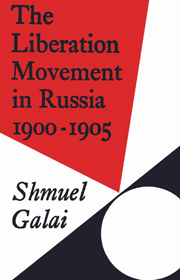Book contents
- Frontmatter
- Contents
- Dedication
- Acknowledgments
- Note on dates, etc.
- List of abbreviations
- Introduction
- Part One ORIGINS
- 1 The origins of zemstvo radicalism
- 2 The beginnings of the zemstvo oppositional movement
- 3 The birth of the democratic intelligentsia
- 4 The parting of the ways
- Part Two THE FORMATION OF THE LIBERATION MOVEMENT
- Part Three WAR AND REVOLUTION
- Appendix A The origins of Beseda
- Appendix B A bibliographical note on the writings of Kuskova and Prokopovich in the years 1898–9
- Appendix C Note on sources on the formation of the Liberation Movement
- Bibliography
- Index
1 - The origins of zemstvo radicalism
Published online by Cambridge University Press: 22 September 2009
- Frontmatter
- Contents
- Dedication
- Acknowledgments
- Note on dates, etc.
- List of abbreviations
- Introduction
- Part One ORIGINS
- 1 The origins of zemstvo radicalism
- 2 The beginnings of the zemstvo oppositional movement
- 3 The birth of the democratic intelligentsia
- 4 The parting of the ways
- Part Two THE FORMATION OF THE LIBERATION MOVEMENT
- Part Three WAR AND REVOLUTION
- Appendix A The origins of Beseda
- Appendix B A bibliographical note on the writings of Kuskova and Prokopovich in the years 1898–9
- Appendix C Note on sources on the formation of the Liberation Movement
- Bibliography
- Index
Summary
Zemstvo radicalism was the offspring of what was referred to in Liberation Movement circles as the ‘Constitutionalist Movement of 1878–81’ or the ‘First Zemstvo Movement’. The development of this group was therefore inextricably connected with the establishment and evolution of the institutions of elective local government.
The Law of 1 January 1864, which provided for the establishment of the zemstvos, was born of both administrative necessity and political considerations. The old local government machinery, established by Catherine II's 1775 Edict on the Provinces, had started to disintegrate at the beginning of the nineteenth century, but reform was not regarded as urgent as long as half Russia's population was composed of serfs who were under the absolute jurisdiction of the nobility. Realizing that once these serfs were emancipated further delay would become impossible, Alexander II appointed a special committee in 1859 to make plans for the reform of local government. This committee was faced with the task of organizing the local government machinery so as to enable it to administer a peasant population which would be doubled after emancipation. It also had to find ways and means of reflecting the new legal status of the liberated serfs in the composition and activities of the reformed local government institutions. And lastly, it was necessary to find ways of compensating the nobility for its loss of political and legal rights over the peasantry, without, at the same time, endangering the foundations of autocracy.
- Type
- Chapter
- Information
- The Liberation Movement in Russia 1900–1905 , pp. 5 - 33Publisher: Cambridge University PressPrint publication year: 1973

